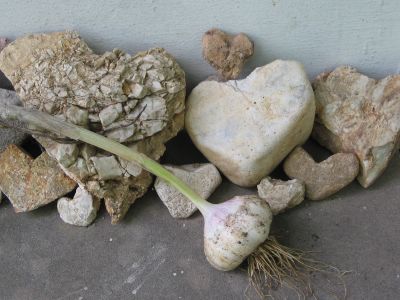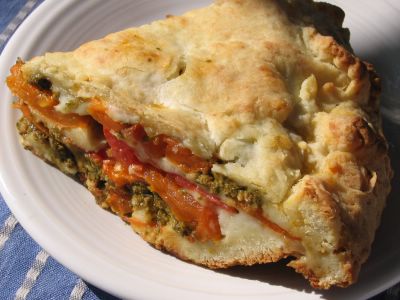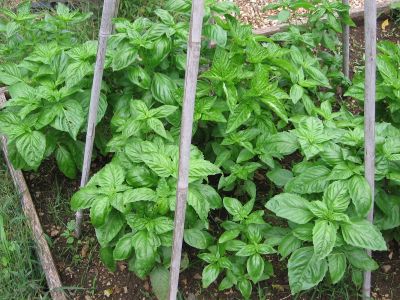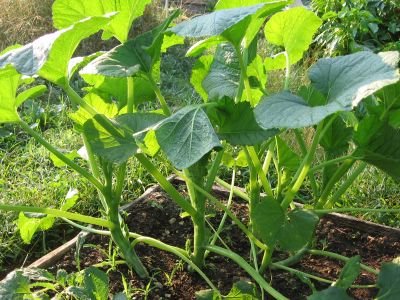
I Heart Homegrown Garlic
It's hard to believe that it's been an entire year since Kalyn put up her first plant post because she didn't have a pet and wanted to join in the weekend fun. What started as a joke between her and Weekend Dog Blogging host Sweetnicks has grown into one of the most popular blogging events around. Food and garden bloggers from all over the world participate in Weekend Herb Blogging, with new people joining in every week. Not only is each weekly recap offer amazing recipes, but it is also chock full of interesting facts and information about practically every kind of herb and edible plant you can imagine. Click here to read the wonderful Year In Review recaps Kalyn has been posting over the past week.
For the one year anniversary, Kalyn has asked everyone to name their favorite herb and then post one of their very best recipes using that herb. Click here to read about this cream of the crop of recipes.
Well, hands down garlic is definitely my very favorite herb. In fact I have been known to say that if a recipe doesn't contain chocolate, then it most likely could do with some garlic. Since garlic figures so much in my cooking (there is even some in the Mexican ground beef that's simmering on the stove as I type this), it wasn't easy to choose one favorite recipe. But this Savory Tomato Pesto Pie, which I created and wrote about this summer on Farmgirl Fare, was not only a big hit with readers, but it also contains my second favorite herb--basil.
So here, once again, is one of my favorite new original recipes, Savory Tomato Pesto Pie. Enjoy!

Worth Turning On The Oven For
Sometimes it is good to be alone in the kitchen. That way, when you pull a pie like this out of the oven and are standing there staring at it cooling on the counter, mesmerized, your mouth watering, stomach rumbling, fingers twitching, you do not have to worry about losing control and getting your hand slapped because you cannot resist it. You can simply tear off a piece of that warm, golden crust with your fingers and pop it into your mouth--and nobody will ever know (because pieces of crust break off all the time). Of course if you end up nibbling off five or six inches of the edge. . . well, you're going to have to come up with a really good explanation as to why it is missing (pets can be quite handy for this). If the pie is just for you, then you will be forced to face the fact that you just gobbled up the very best part off a large portion of your pie.
This recipe (which I created in my head a few days ago and then created in the kitchen the following night) is actually a combination of four things that I love. The first is pizza. The second is homemade pecorino romano crackers (yet another recipe I've been meaning to share for over a year now) which I don't make very often because Joe doesn't care for them. This means it is up to me to eat them all--and I have absolutely no self-control when they are around. I have had entire meals that consisted of nothing but these crackers. The third thing is a similar pie I've made with tomatoes, cheddar cheese and fresh basil using a recipe from a 1998 issue of Country Home magazine. The fourth thing is something I invented on a whim years ago when I had my little bakery cafe in California. It was basically a freeform calzone made with a biscuit-type crust and filled with sliced roma tomatoes, mozzarella cheese, and pesto. I called them Pesto Piezones, and each one was about the size of both of my hands put together (with fingers spread apart). I sold them for four dollars apiece, and they were usually all spoken for well before lunchtime. Until the other day I had forgotten all about them.
Now this may look like a pie (and I may even be calling it a pie), but it is really not a pie. So those of you who are afraid of pies can keep on reading. And now I'm going to say this again in a slightly different way because people who are afraid of making pies have often been tricked into making them and then suffered traumatic experiences: This is not a piecrust. It is made with a biscuit dough, but (for those of you who are afraid of making biscuits) it is not made from biscuits. This dough is easy to work with. This pie is quick and easy to make. That--for anyone who is still suspicious--means that this is by no means a difficult culinary endeavor. You can make this pie. Yes, you. And when you do--if you decide to share it--it will most likely make whomever you feed it to immediately smile with delight and love you even more than they already do. And you certainly can't beat that.
Purchased pesto will give you perfectly good results in this recipe, but if you have half an hour to spare and can get your hands on some beautiful fresh basil, by all means make your own. Use your favorite recipe or try my latest version that I created specifically to use in this pie. It is adapted from the Basil Pesto recipe in The Sonoma Diet book, which I am currently reviewing.
(Since I have no idea if or when I will actually get around to finishing the review, let me just say this: I highly recommend The Sonoma Diet book for anyone who loves great-tasting, real food that also happens to be good for you--regardless of whether you want to lose weight. The book basically offers a new way of thinking about and appreciating food, and it doesn't involve counting or measuring or scary meal replacements. In my opinion, the "Seasonings" recipe section alone is worth the price of the book. And the Peachy Berry Cobbler came together in minutes and did not taste like diet food.)
The Sonoma Diet pesto recipe caught my eye because it called for pine nuts or almonds. I never put pine nuts in my pesto. I don't particularly care for them, and they are always frightfully expensive. Almonds, however, I like. And compared to pine nuts, they are a bargain. I had never thought of using almonds in pesto and was thrilled with the results. I'm looking forward to enjoying this new pesto in other ways besides in this pie and by the spoonful. (If desired, you can omit the almonds or substitute pine nuts in the recipe.) The tomatoes are my own addition. They give the pesto a whole new flavor while making it thin enough so as to be spreadable. You can save time by making the pesto a day or two ahead. Or you can make the entire pie ahead of time and simply reheat it in the oven. Individual leftover slices can be wrapped in foil and reheated in the oven or toaster oven, although it isn't too bad cold either. If you are very, very gentle, you can heat a slice in the microwave.
What I like most about this recipe is that although the tomatoes are cooked, they manage to maintain their fresh-from-the-garden taste. Yes, I've gone from Summer In A Bowl to summer in a crust. Be sure to use the meaty plum/roma tomatoes, as other varieties are too juicy. As always, I urge you to seek out the best locally produced and organic ingredients you can find. They will make all the difference in this (and any) recipe. Enjoy.
Farmgirl's Savory Tomato Pesto Pie
Makes One 9-Inch Pie
For The Pesto:
Makes about 1-1/2 cups (you will need 1 cup)
1/2 cup (about 2-1/2 ounces) raw whole almonds (optional)
4 ounces fresh basil leaves (about 4 cups packed, but it's best if you weigh it)
6 Tablespoons extra-virgin olive oil
6 cloves of garlic
4 Tablespoons finely grated pecorino romano cheese
10 ounces tomatoes (about 3 smallish ones), any kind, quartered
1/2 teaspoon nice salt
Spread the almonds on a baking sheet or piece of aluminum foil and place them in a 350 degree oven or toaster oven for 8 to 10 minutes. Mix all ingredients, including almonds, in a food processor until thoroughly combined. (You could probably also use a blender--or a gigantic mortar and pestle if you are trying to build up your arm muscles.) Add more salt to taste if necessary. Heat the oven to 375 degrees F.
For The Crust:
2 cups all-purpose flour (I use Heartland Mill organic)
4 teaspoons baking powder (make sure it's fresh!) **
1 teaspoon salt
1/2 cup (1 stick/ 4 ounces) cold butter
1 cup (about 2-1/2 ounces) finely grated pecorino romano (or other hard cheese)
3/4 cup milk
Combine the flour, baking powder, and salt in a medium bowl. Mix in the butter using a pastry blender, fork, or your fingers until the largest pieces are pea-size. Stir in the pecorino romano. Pour in the milk and use a fork to gently form a soft dough. Do not overmix. Divide the dough in two pieces, making one slightly larger than the other.
On a generously floured surface, use a rolling pin to gently roll out the larger piece of dough into a circle about 12 inches across, rolling from the center outward. Sprinkle dough with flour if sticky. Gently fold the dough in half and transfer into a 9-inch pie pan. If the dough tears, simply press it back together with your fingers. Roll out the remaining piece of dough into a slightly smaller circle and set aside (or wait until you have the filling in the pan and then roll it out).
Assembling The Pie:
1 cup pesto, divided
2-1/2 pounds of the best plum tomatoes you can find, sliced lengthwise into 4 or 5 slices each (I used San Marzanos & Golden Romas to add extra color as well as more flavor)
8 ounces mozzarella, grated or thinly sliced (I used fresh which can't be grated)
1/2 cup (about 1-1/4 ounces) finely grated pecorino romano (or other hard cheese)
Using a spoon, spread 1/2 cup of pesto over the bottom layer of dough in the pie pan. Layer about half of the tomatoes over the pesto. Cover the tomatoes with about 2/3 of the mozzarella. Layer on the rest of the tomatoes (you may not need them all to fill the pan). Carefully spread the remaining 1/2 cup of pesto over the tomatoes. Cover with the remaining mozzarella and the pecorino romano.
Roll out the second piece of dough if you haven't already, and carefully place it over the pie. Fold the edge of the bottom piece over the top piece and press together to seal. Use your fingers to make a crimped design around the edge. If any dough falls apart, simply press it back together with your fingers. Don't worry if it isn't perfect. The handmade look has much more charm. Cut four slits in the top of the pie for steam to escape. Bake at 375 degrees F in the center of the oven until the crust is golden brown, about 40 minutes. Cover the edge with foil if it starts to brown too quickly.
Let cool on a wire rack for at least 15 minutes before serving. Crust edges may be sampled much sooner. (As with nearly any fruit pie, if you cut into it while it is still warm, some juice will seep out. If you plan to store any leftover pie right in the pan, simply drain off the juice so the bottom crust doesn't become soggy.) Or cool pie completely, cover, and refrigerate.
This pie also freezes beautifully. I wrapped a hunk in foil then put it in a zipper freezer bag and tossed it into the freezer. I defrosted the whole piece overnight in the refrigerator, then cut it in half and reheated the slices in my handy little DeLonghi Convection Oven for 15-20 minutes at 325 degrees, each on a fresh piece of foil and covered lightly with the foil so the tops wouldn't brown too quickly. The bottom crust was a bit soggy, but I'm pretty sure that was because I let the pie sit in the fridge three days before deciding to freeze it. Otherwise it looked and tasted as if it had just come out of the oven the first time. Hint: If you plan to freeze the entire pie and don't want to freeze it in the pan, use a disposable pie pan or line your pan with a piece of heavy duty foil so you can simply lift the whole cooled pie out of the pan.
Other Ideas:
--Use arugula pesto or spinach pesto instead of basil pesto.
--Omit the pecorino romano from the crust, and use cilantro pesto (thinned with salsa, if desired) and jalapeno jack cheese in place of the basil pesto and mozzarella.
**Fresh baking powder is essential to the success of any recipe that calls for it. If your baking powder is more than a couple of months old, toss it out and buy a new container. It will cost you about two dollars, and your homemade baked goods are surely worth much more than that. I buy Rumford brand because it does not contain aluminum and consistently gives me good results.
Entire Contents Copyright 2006 FarmgirlFare.com.


















